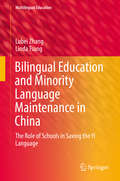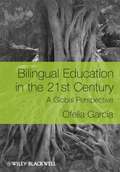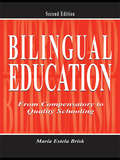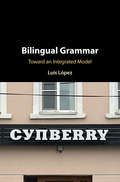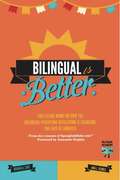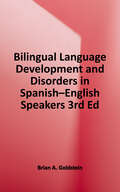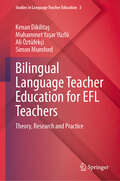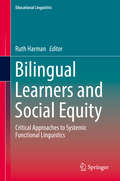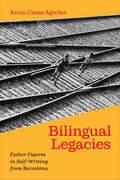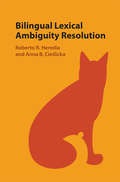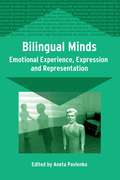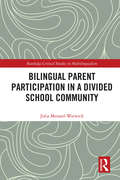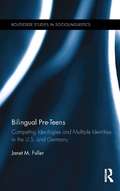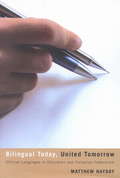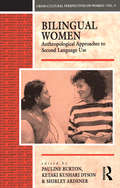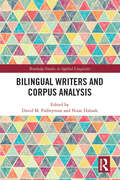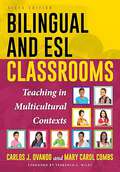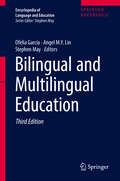- Table View
- List View
Bilingual Education and Minority Language Maintenance in China: The Role of Schools in Saving the Yi Language (Multilingual Education #31)
by Linda Tsung Lubei ZhangThis book looks closely at Yi bilingual education practice in the southwest of China from an educationalist’s perspective and, in doing so, provides an insight toward our understanding of minority language maintenance and bilingual education implementation in China. The book provides an overview on the Yi people since 1949, their history, society, culture, customs and languages. Adopting the theory of language ecology, data was collected among different Yi groups and case studies were focused on Yi bilingual schools. By looking into the application of the Chinese government’s multilingual language and education policy over the last 30 years with its underlying language ideology and practices the book reveals the de facto language policy by analyzing the language management at school level, the linguistic landscape around the Yi community, as well as the language attitude and cultural identities held by present Yi students, teachers and parents. The book is relevant for anyone looking to more deeply understand bilingual education and language maintenance in today’s global context.
Bilingual Education in the 21st Century
by Ofelia GarcíaBilingual Education in the 21st Century examines languages and bilingualism as individual and societal phenomena, presents program types, variables, and policies in bilingual education, and concludes by looking at practices, especially pedagogies and assessments. This thought-provoking work is an ideal textbook for future teachers as well as providing a fresh view of the subject for school administrators and policy makers.Provides an overview of bilingual education theories and practices throughout the worldExtends traditional conceptions of bilingualism and bilingual education to include global and local concerns in the 21st centuryQuestions assumptions regarding language, bilingualism and bilingual education, and proposes a new theoretical framework and alternative views of teaching and assessment practicesReviews international bilingual education policies, with separate chapters dedicated to US and EU language policy in educationGives reasons why bilingual education is good for all children throughout the world, and presents cases of how this is being carried out
Bilingual Education: From Compensatory to Quality Schooling (2nd Edition)
by María Estela BriskBilingual Education: From Compensatory to Quality Schooling, Second Edition maintains its original purpose of synthesizing the research on successful bilingual education in order to demonstrate that quality bilingual education is possible and desirable.Findings from a wide range of studies are integrated to provide a clear picture of bilingual education in today's schools, and a professional understanding of the foundations and issues surrounding bilingual education programs. The recommendations offered provide a comprehensive basis for planning, developing, improving, and evaluating bilingual programs. For clarity, these recommendations are discussed with respect to the whole school, the curriculum, and the classroom, but it is stressed that they need to be applied in a holistic way because they depend on each other. All educators who work or will work with bilingual students--classroom teachers, administrators, and curricula developers--will find the information in this text essential and will appreciate the straightforward approach and easy reading style.New in the Second Edition:*A new Chapter 1, Pursuing Successful Schooling, includes the definition of success that frames the content of the book, and a review of how the research on bilingual education has changed.*Chapter 2, Bilingual Education Debate, is substantially revised to address major changes in demographics and legislation.*Chapter 3, Contextual and Individual Factors: Supports and Challenges, is updated to include important new research on the external and internal factors affecting learners and a new section on peers.*Chapter 4, Creating a Good School, is reorganized and updated.*Chapter 5, Creating Quality Curriculum, is updated throughout, particularly the sections on teaching content areas and assessment.*Chapter 6, Creating Quality Instruction, includes extensive new material in the sections on "Teaching English and In English" and "Teaching Students with Limited Schooling."*Chapter 7, Beyond the Debate, has an extensive new section describing and analyzing how the framework for quality education can be used as a guide to help create a new program.
Bilingual Education: Teachers' Narratives
by Nancy LembergerThis book grew out of the joys and challenges the author experienced as a Spanish/English bilingual teacher of culturally and linguistically diverse students. It tells what it is like to be a bilingual teacher. As a result, it helps other teachers and prospective teachers understand the complex nature of bilingual teaching, shares some successful teaching strategies that other teachers have used, and encourages teachers to find their own solutions despite limited support. The book is structured in three parts. The introduction explains how the book evolved, defines its relation to other qualitative research, and offers suggestions for how to use the book. The second part consists of eight bilingual teachers' stories that provide a glimpse of them as people, their schools and programs, their successes and struggles, and their solutions and coping mechanisms within their contexts. It concludes with a discussion chapter that looks at the teachers' collective strengths and struggles comparatively, connecting these to broader issues. The final section presents bilingual education resources -- useful information for practitioners. This includes foundation texts on the theories and practices of bilingual education, demographic information, a glossary of bilingual education terms, listings of curricula, tests, and literature mentioned by the teachers, and professional network sources.
Bilingual Figurative Language Processing
by Roberto R. Heredia Anna B. CieślickaBilingual Figurative Language Processing is a timely book that provides a much-needed bilingual perspective to the broad field of figurative language. This is the first book of its kind to address how bilinguals acquire, store, and process figurative language, such as idiomatic expressions (e. g. , kick the bucket), metaphors (e. g. , lawyers are sharks), and irony, and how these tropes might interact in real time across the bilingual's two languages. This volume offers the reader and the bilingual student an overview of the major strands of research, both theoretical and empirical, currently being undertaken in this field of inquiry. At the same time, Bilingual Figurative Language Processing provides readers and undergraduate and graduate students with the opportunity to acquire hands-on experience in the development of psycholinguistic experiments in bilingual figurative language. Each chapter includes a section on suggested student research projects. Selected chapters provide detailed procedures on how to design and develop psycholinguistic experiments.
Bilingual Grammar: Toward an Integrated Model
by Luis LópezDoes a bilingual person have two separate lexicons and two separate grammatical systems? Or should the bilingual linguistic competence be regarded as an integrated system? This book explores this issue, which is central to current debate in the study of bilingualism, and argues for an integrated hypothesis: the linguistic competence of an individual is a single cognitive faculty, and the bilingual mind should not be regarded as fundamentally different from the monolingual one. This conclusion is backed up with a variety of empirical data, in particular code-switching, drawn from a variety of bilingual pairs. The book introduces key notions in minimalism and distributed morphology, making them accessible to readers with different scholarly foci. This book is of interest to those working in linguistics and psycholinguistics, especially bilingualism, code-switching, and the lexicon.
Bilingual Health Communication: Working with Interpreters in Cross-Cultural Care
by Elaine HsiehThis book examines interpreter-mediated medical encounters and focuses primarily on the phenomenon of bilingual health care. It highlights the interactive and coordinated nature of interpreter-mediated interactions. Elaine Hsieh has put together over 15 hours of interpreter-mediated medical encounters, interview data with 26 interpreters from 17 different cultures/languages, 39 health care providers from 5 clinical specialties, and surveys of 293 providers from 5 clinical specialties. The depth and richness of the data allows for the presentation of a theoretical framework that is not restricted by language combination or clinical contexts. This will be the first book of its kind that includes not only interpreters’ perspectives but also the needs and perspectives of providers from various clinical specialties. Bilingual Health Communication presents an opportunity to lay out a new theoretical framework related to bilingual health care and connects the latest findings from multiple disciplines. This volume presents future research directions that promise development for both theory and practice in the field.
Bilingual Is Better
by Roxana A. Soto Ana L. FloresFor years immigrants were told that the only way for their children to embrace American culture was to leave behind their heritage language and speak only English. But what if this advice was based solely on political motives and not the wellbeing of children? What if the truth was that all children in America, regardless of their cultural background, would actually benefit from learning two languages? The answer to this question has sparked a new Latino parenting revolution, which is changing the face of America. Roxana and Ana, founders of the wildly successful parenting blog SpanglishBaby, are part of a growing movement of Latino parents who are proudly reclaiming their language and cultural heritage for themselves and their children. Laugh and cry with them as they stumble through the ups and downs of raising bilingual, bicultural children in America and discover themselves in the process. This inspiring parenting memoir includes practical tips and resources to help parents from all backgrounds give their children the benefits of bilingualism. Bilingual Is Better debunks old stereotypes while shedding new light on hot topics like bilingual education, cultural heritage and what it really means to be Latino. A perfect blend of hilarious anecdotes and solid research, this book is a fun, engaging read which is sure to spark conversation and positive change. Roxana A. Soto and Ana L. Flores co-founded the popular parenting blog SpanglishBaby, which was recently named a Must Read Mom's Blog by Parenting magazine. Both authors are well known, award-winning bilingual journalists.
Bilingual Language Acquisition
by Carmen Silva-CorvalánHow do children develop bilingual competence? Do bilingual children develop language in the same way as monolinguals? Set in the context of findings on language development, this book examines the acquisition of English and Spanish by two brothers in the first six years of their lives. Based on in-depth and meticulous analyses of naturalistic data, it explores how the systems of both languages affect each other as the children develop, and how different levels of exposure to each language influence the nature of acquisition. The author demonstrates that the children's grammars and lexicons follow a developmental path similar to that of monolinguals, but that cross-linguistic interactions affecting lexical, semantic and discourse-pragmatic aspects arise in Spanish when exposure to it diminishes around the age of four. The first of its kind, this original study is a must-read for students and researchers in bilingualism, child development, language acquisition and language contact.
Bilingual Language Development & Disorders In Spanish-english Speakers
by Barbara Zurer Pearson Nan Bernstein Ratner Janet L. Patterson Li Sheng Raúl Rojas Brian A. Goldstein Carol Scheffner Hammer Barbara Rodríguez Megha Sundara Adriana Soto-Corominas Ellen Stubbe Kester Solaman J. Cooperson Raquel T. Anderson Aquiles Iglesias M. Adelaida Restrepo Kai Greene Christine E. Fiestas Megan Dunn Davison María R. Brea Christina Gildersleeve-Neumann Lucía I. Méndez Sonja Pruitt-Lord Elizabeth D. Peña Lisa Bedore Lisa Lopez Kelly Escobar Julie C. SmithDual language learners are the fastest-growing segment of the U.S. student population, and the majority speak Spanish as a first language. This graduate-level textbook—now in its third edition—gives future speech-language pathologists the comprehensive knowledge they need to work effectively with Spanish–English bilingual children and support their language development. Aligned with current best practices and updated with the latest research and new chapters on critical topics, this book prepares SLPs for practice with cutting-edge information on language development and disorders of Spanish–English bilingual children. More than 25 leading researchers compile the high-level knowledge SLPs need to understand the complexity of language development in bilingual children, distinguish language differences from disorders accurately, and conduct effective assessment and intervention. An essential graduate text that will also be a trusted reference for practicing professionals, this third edition gives current and future SLPs a broad, deep, and nuanced understanding of communication development and disorders in Spanish–English bilingual children.
Bilingual Language Teacher Education for EFL Teachers: Theory, Research and Practice (Studies in Language Teacher Education #3)
by Kenan Dikilitaş Muhammet Yaşar Yüzlü Ali Öztüfekçi Simon MumfordThis book is designed for English as a foreign language (EFL) teachers to shape their teaching practices and integrate bilingual education. It investigates the emerging context of bilingualism in schools where non-bilingual children are taught both through their native language and English as the second language.· Part I focuses on the theoretical underpinnings of bilingualism in EFL contexts. · Part II explores empirical research into bilingual teaching education. · Part III provides teaching pedagogies embracing dynamic bilingualism in EFL contexts and offers practical suggestions for EFL teachers creating instructional and interactional spaces.· Part IV is dedicated to practice-based, hands-on activities both for pre-service and in-service EFL teachers. This book is intended for language teachers, students in language teacher education graduate programs, researchers in EFL contexts, and language teacher educators and trainers. It empowers stakeholders to re-envision, and ultimately transform, bilingual education critically and practically, promoting the building of stronger identities.
Bilingual Learners and Social Equity: Critical Approaches to Systemic Functional Linguistics (Educational Linguistics #33)
by Ruth HarmanThis volume explores how educators conceptualized and implemented critical approaches to systemic functional linguistics that support bilingual students in appropriating and challenging dominant knowledge domains in K-16 contexts. The researchers exhibit a shared commitment to enacting a culturally sustaining SFL praxis that validates multilingual meaning making, pushes against social inequity, and fosters creative re-mixing of available semiotic resources. It should prove a valuable resource for students, teachers and researchers interested in applied linguistics, education and critical theory.
Bilingual Legacies: Father Figures in Self-Writing from Barcelona (Toronto Iberic)
by Anna Casas AguilarBilingual Legacies examines fatherhood in the work of four canonical Spanish authors born in Barcelona and raised during the dictatorship of Francisco Franco. Drawing on the autobiographical texts of Juan Goytisolo, Carlos Barral, Terenci Moix, and Clara Janés, the book explores how these authors understood gender roles and paternal figures as well as how they positioned themselves in relation to Spanish and Catalan literary traditions. Anna Casas Aguilar contends that through their presentation of father figures, these authors subvert static ideas surrounding fatherhood. She argues that this diversity was crucial in opening the door to revised gender models in Spain during the democratic period. Moving beyond the shadow of the dictator, Casas Aguilar shows how these writers distinguished between the patriarchal "father of the nation" and their own paternal figures. In doing so, Bilingual Legacies sheds light on the complexity of Spanish conceptions of gender, language, and family and illustrates how notions of masculinity, authorship, and canon are interrelated.
Bilingual Lexical Ambiguity Resolution
by Roberto R. Heredia Anna B. CieślickaThis book provides students and researchers of bilingualism with the most recent methodological and theoretical advances on how bilinguals resolve ambiguous information across languages. With reports on the latest findings from the behavioral and neuropsychological fields, the authors survey the latest research into bilingual language-system modelling and bilingual lexical ambiguity processing. Each chapter looks at bilingual ambiguity resolution both at the word and sentence levels, explaining how bilinguals ultimately comprehend ambiguous information arising from languages they already know. This volume not only explores enduring theoretical questions in bilingual research, such as bilingual representation and language processing, but also evaluates the extent to which the existing bilingual models can satisfactorily account for the most recent research findings.
Bilingual Minds
by Aneta PavlenkoDo bi- and multilinguals perceive themselves differently in their respective languages? Do they experience different emotions? How do they express emotions and do they have a favourite language for emotional expression? How are emotion words and concepts represented in the bi- and multilingual lexicons? This ground-breaking book opens up a new field of study, bilingualism and emotions, and provides intriguing answers to these and many related questions.
Bilingual Parent Participation in a Divided School Community (Routledge Critical Studies in Multilingualism)
by Julia Menard-WarwickThis volume theorizes parent participation in a bilingual school community in California, unpacking broader issues around language ideologies, language and power, and parent collaboration in diverse educational contexts. Highlighting data from a two-year ethnographic study of the school community, the book grounds this discussion in theories of discourse and bilingualism, with a focus on translanguaging and translingual practice. The volume points to a range of challenges and questions posed by the parents’ efforts to unite as a single school community, including linguistic inequality, cultural divides, and differing implicit beliefs on language. The book documents these efforts as a means to demonstrate the ways in which monolingual practices are reinforced in these settings, despite best efforts, but also as a point of departure to discuss implications and a way forward for parent collaboration in bilingual school communities more generally. Offering a nuanced portrait of the impact of parent collaboration in bilingual school communities, this volume will be of particular interest to graduate students and scholars in language education, applied linguistics, bilingualism, and sociolinguistics.
Bilingual Pre-Teens: Competing Ideologies and Multiple Identities in the U.S. and Germany (Routledge Studies in Sociolinguistics #6)
by Janet M. FullerThis volume examines the connection between socio-economic class and bilingual practices, a previously under-researched area, through looking at differences in bilingual settings that are classified as "immigrant" or "elite" and are thus linked to socio-economic class categories. Fuller chooses for this examination bilingual pre-teen children in Germany and the U.S. in order to demonstrate how local identities are embedded in a wider social world and how ideologies and identities both produce and reproduce each other. In so doing, she argues that while pre-teen children are clearly influenced by macro-level ideologies, they also have agency in how they choose to construct their identities with relation to hegemonic societal discourses, and have many other motivations and identities aside from social class membership which shape their linguistic practices.
Bilingual Study and Research: The Need and the Challenges (Ius Comparatum - Global Studies in Comparative Law #58)
by Nicolás Etcheverry EstrázulasThis book addresses the importance of bilingualism in legal education. Written by respected experts in the field, it presents reports on bilingual legal education in countries with such diverse cultures and histories as Belgium, Canada, China, the Czech Republic, Finland, France, Germany, Italy, Japan, Mexico, Romania, Singapore, Taiwan and the USA. The findings are also summarized in a General Report that was presented at the 20th IACL General Congress in Fukuoka, Japan.
Bilingual Today, United Tomorrow
by Matthew HaydayHayday shows how the language programs and policies initiated by the Trudeau government supported French-Canadian and Acadian minority communities, enabling them to develop minority language education systems and laying the groundwork for the minority language education rights contained in section 23 of the Canadian Charter of Rights and Freedoms. He examines how the dynamics of Canadian federalism shaped the implementation and development of language policy in six Canadian provinces and shows how advocates of these programs - politicians, bureaucrats, parents, lobbyists, and teachers - worked to ensure their success. These dynamic programs not only guaranteed minority language education rights but dramatically increased access to French second language instruction, particularly through the innovative new sector of French immersion.
Bilingual Today, United Tomorrow: Official Languages in Education and Canadian Federalism
by Matthew HaydayHayday shows how the language programs and policies initiated by the Trudeau government supported French-Canadian and Acadian minority communities, enabling them to develop minority language education systems and laying the groundwork for the minority language education rights contained in section 23 of the Canadian Charter of Rights and Freedoms. He examines how the dynamics of Canadian federalism shaped the implementation and development of language policy in six Canadian provinces and shows how advocates of these programs - politicians, bureaucrats, parents, lobbyists, and teachers - worked to ensure their success. These dynamic programs not only guaranteed minority language education rights but dramatically increased access to French second language instruction, particularly through the innovative new sector of French immersion.
Bilingual Women: Anthropological Approaches to Second Language Use (Cross-cultural Perspectives On Women Ser. #Vol. 9)
by Pauline Burton; Ketaki Kushari Dyson; Shirley ArdenerThis book studies women's language use in bilingual or multi-lingual cultural situations. The authors - social anthropologists, language teachers, and interpreters cover a wide variety of geographical and linguistic situations, from the death of Gaelic in the Outer Hebrides, to the use of Spanish by Quechua and Aymara women in the Andes. Certain common themes emerge: dominant and sub-dominant languages, women's use of them; ambivalent attitudes towards women as translators, interpreters and writers in English as a second language; and the critical role of women in the survival (or death) of minority languages such as Gaelic and Breton.
Bilingual Writers and Corpus Analysis (Routledge Studies in Applied Linguistics)
by David M. Palfreyman Nizar HabashThis innovative volume is one of the first to represent the usage of bilingual writers in both their languages, offering insight into language corpora as extremely valuable tools in contemporary applied linguistics research, and in turn, into how much of the world’s population operate daily. This book discusses one of the first examples of a bilingual writer corpus, the Zayed Arabic-English Bilingual Undergraduate Corpus (ZAEBUC), which includes writing by hundreds of students in two languages, with additional information about the writers and the texts. The result is a rich resource for research in multilingual use and learning of language. The book takes the reader through the design and use of such a corpus and illustrates the potential of this type of corpus with detailed studies that show how assessment, vocabulary, and discourse work across two very different languages. This volume will be of interest to scholars, policymakers, and educators in bilingualism, plurilingualism, language education, corpus design, and natural language processing.
Bilingual and ESL Classrooms: Teaching in Multicultural Contexts
by Carlos J. Ovando Mary Carol CombsNow in its 6th Edition, this classic text integrates theory and practice to provide comprehensive coverage of bilingual and ESL education. The text covers the foundations of bilingual and ESL education and provides a strong focus on what the teacher needs to know in a bilingual classroom. Woven throughout the text are quotes from bilingual and ESL students and teachers that illuminate the bilingual/ESL learning and teaching experience. Bilingual and ESL Classrooms is written for both preservice and experienced educators serving grades pre-K through 12—mainstream, bilingual, ESL, and special education teachers, as well as administrators, school counselors, and educational policymakers. New in the Sixth Edition This sixth edition presents updated research on and expanded coverage of key issues related to the education of English language learners in the United States such as continuing controversies and findings in demographics, the impact of globalization on K–12 public schooling, evidence-driven teaching practices, white normativity, using technologies developed for language minority populations, making sense of Census 2010, and achievement levels of ELLs in math and science. More specifically, this sixth edition includes: Coverage of the 2015 Every Student Succeeds Act. An expanded and updated “Human Face of Bilingual Students and ELLs.” A revised, co-authored student chapter. A thoroughly revised assessment chapter. A revised chapter on bilingual special education.
Bilingual and Multilingual Education in the 21st Century
by Christian Abello-Contesse Paul M ChandlerBilingual education is one of the fastest growing disciplines within applied linguistics. This book includes the work of 20 specialists working in various educational contexts across Europe, Latin America and North America to create a volume which is both comprehensive in scope and multidimensional in its coverage of current bilingual initiatives. The central themes of this volume, which draws on past experiences of bilingual education, include issues in language use in classrooms at elementary, secondary and tertiary levels; participant perspectives on bilingual education experiences; and the language needs of bi- and multilingual students in monolingual schools. This collection will be of interest to teachers and administrators in bi- and multilingual education programs, as well as scholars working in the field of language education.
Bilingual and Multilingual Education: Implications For Sla, Tesol, And Bilingual Education (Encyclopedia of Language and Education #Vol. 5)
by Ofelia García Stephen May Angel M. Y. LinIn this third, fully revised edition, the 10 volume Encyclopedia of Language and Education offers the newest developments, including an entirely new volume of research and scholarly content, essential to the field of language teaching and learning in the age of globalization. In the selection of topics and contributors, the Encyclopedia reflects the depth of disciplinary knowledge, breadth of interdisciplinary perspective, and diversity of socio-geographic experience in the language and education field. Throughout, there is an inclusion of contributions from non-English speaking and non-western parts of the world, providing truly global coverage. Furthermore, the authors have sought to integrate these voices fully into the whole, rather than as special cases or international perspectives in separate sections. The Encyclopedia is a necessary reference set for every university and college library in the world that serves a faculty or school of education, as well as being highly relevant to the fields of applied and socio-linguistics. The publication of this work charts the further deepening and broadening of the field of language and education since the publication of the first edition of the Encyclopedia in 1997 and the second edition in 2008.
